
Abstract
While student-athletes are the backbone of the $11 billion college sports industry, they do not currently receive any of this revenue derived from the use of their names, images, and likenesses. The National College Athletic Association’s mission is to maintain the amateur status of student-athletes. In doing so, it precludes student-athletes from receiving any type of compensation outside of the actual cost of tuition. Amateurism, as a concept, promotes the distinction between professional and student athletes, and is the crux of the NCAA’s argument for prohibiting the compensation of student-athletes. Recently, however, the controversy surrounding the amateur status of college athletes has resulted in antitrust challenges to the NCAA’s regulations.
This note provides an analysis of the recent litigation, with a particular focus on O’Bannon v. NCAA. In line with the Ninth Circuit’s decision in O’Bannon, this note concludes that prohibiting all compensation of college athletes outside of a grant-in-aid is no longer a legal or viable option for the NCAA. The NCAA was compelled to update its practices or else face paying damages to a large, injured class of former student-athletes. In continuing with this reform, this note articulates an alternative regulatory approach in which the NCAA would permit universities to enter into a revenue-sharing system with their student-athletes. This suggested model promotes adequate compensation of student-athletes, while simultaneously maintaining the core values of amateurism.
Recommended Citation
Audrey C. Sheetz,
Student-Athletes vs. NCAA: Preserving Amateurism in College Sports Amidst the Fight for Player Compensation,
81 Brook. L. Rev.
(2016).
Available at:
https://brooklynworks.brooklaw.edu/blr/vol81/iss2/10
Included in
Antitrust and Trade Regulation Commons, Contracts Commons, Entertainment, Arts, and Sports Law Commons, Labor and Employment Law Commons

